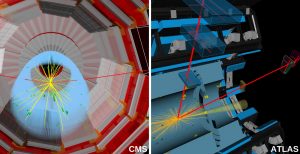 On August 2020, during the ICHEP 2020 Conference, the CMS experiment at Large Hadron Collider (LHC) at CERN of Geneva, announced the evidence of Higgs Boson decay in muon pairs.
On August 2020, during the ICHEP 2020 Conference, the CMS experiment at Large Hadron Collider (LHC) at CERN of Geneva, announced the evidence of Higgs Boson decay in muon pairs.
The Higgs Boson, first observed by ATLAS and CMS Collaborations in 2012, is the particle demonstration of the Higgs field, a filed surrounding the full space and that gives mass to all the matter.
Since its discovery CERN physicists started to study its characteristics such as how, once produced, it decays in lighter particles. According to the Standard Model, the best description so far available of the particle behaviour, the probabilitiy of Higgs Boson decay in other particles depends on the mass of these particles: bigger is the mass, bigger is the probability to decay in these particles.
Up to now there were evidence of Higgs Boson decays only in higher mass particles like W and Z bosons, or heavier fermions. The experiment has for the first time highlighted a rare decay in lighter particles, two muons, that just involves one Higgs Boson on 5000. This is a further confirmation of the Standard Model and opens the way to rare decays studies of the Higgs Boson.
The CMS experiment has reached a meaningfulness of 3, that means that the probability that the excess of events found is not really due to the Higgs Boson decay but to a statistical fluctuation is less than one in 700. If we also add the evidence of the ATLAS experiment that has reached a meaningfulness of 2 (corresponding to a probability of a statistical fluctuation lower than one in 40), an evidence of more than 3 sigma has been reached.
When LHC will start again its operations, new events will be collected and a more precise measurement will be possible.
A crucial role for this kind of analysis has been covered by the muon detectors to whose construction and functioning the groups of Frascati of both CMS and ATLAS have given important contributions.
 INFN-LNF Laboratori Nazionali di Frascati
INFN-LNF Laboratori Nazionali di Frascati